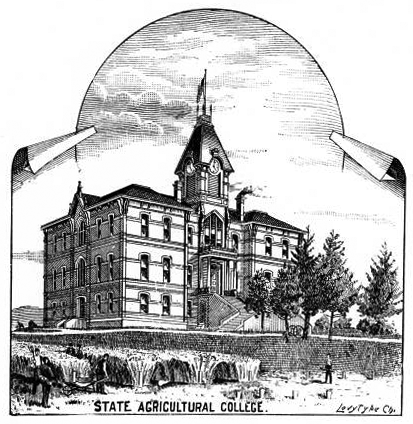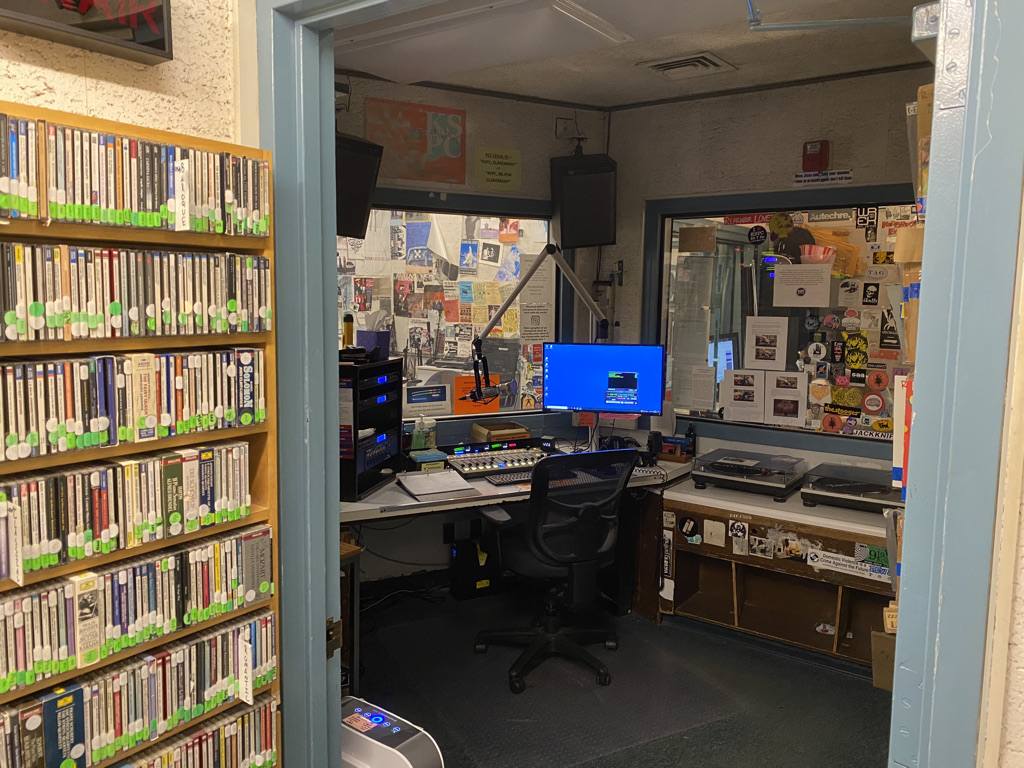|
KBVR
KBVR (88.7 FM) is a student-run non-commercial radio station broadcasting a variety format. Licensed to Corvallis, Oregon, United States, the station is currently owned by Oregon State University. KBVR is part of Orange Media Network, the student media department at OSU. The station can be heard in about a 30-mile radius around Corvallis, depending on altitude. KBVR was founded in 1966. History KBVR-FM 88.7 was originally broadcast from Shepherd Hall on the Oregon State University Campus in 1965 at 90.1 MHz with 10 watts of power and a 4 to 5 mile listening radius. The station relocated to Snell Hall in 1977, and continued to expand its listening area to the current radius of 30 miles using 340 watts of power and moved to its current 88.7 MHz frequency. The station relocated again in 2015 to its current location in the university's Student Experience Center. In the first six months of operations, KBVR-FM (90.1 then) was only on the air from 6:00 to 7:00 pm Monday th ... [...More Info...] [...Related Items...] OR: [Wikipedia] [Google] [Baidu] |
Oregon State University
Oregon State University (OSU) is a Public university, public Land-grant university, land-grant research university in Corvallis, Oregon, United States. OSU offers more than 200 undergraduate degree programs and a variety of graduate and doctoral degrees through all 11 of the university's colleges. It has the seventh-largest engineering college in the nation (2023). Undergraduate enrollment for all colleges combined averages over 32,000 while an additional 5,000 students are engaged in post-graduate coursework through the university. In 2023, over 37,000 students were enrolled at OSU, making it the largest university in the state. Out-of-state students typically make up over one-quarter of the student body. Since its founding, over 272,000 students have graduated from OSU. The university is Carnegie Classification of Institutions of Higher Education, classified among "R1: Doctoral Universities – Very high research activity". Initially chartered as a land-grant university, OS ... [...More Info...] [...Related Items...] OR: [Wikipedia] [Google] [Baidu] |
Corvallis, Oregon
Corvallis ( ) is a city in and the county seat of Benton County, Oregon, Benton County in central western Oregon, United States. It is the principal city of the Corvallis, Oregon Metropolitan Statistical Area, which encompasses all of Benton County. As of the 2020 United States census, 2023 Census Population Estimates, the population was 61,087, making it the List of cities in Oregon, 9th most populous city in Oregon. This does include the 38,000 Oregon State University students attending classes in Corvallis, over 5,250 of whom live in one of 16 residence halls on the main campus. Corvallis is the location of Oregon State University 420-acre main campus, Samaritan Health Services, a top 10 largest non-profit employer in the state, a 84-acre Good Samaritan Regional Medical Center (Oregon), Good Samaritan Regional Medical Center campus, and a 2.2 million square foot, 197-acre Hewlett Packard research and development campus. Corvallis is a part of the Silicon Forest. Corvallis is ... [...More Info...] [...Related Items...] OR: [Wikipedia] [Google] [Baidu] |
List Of College Radio Stations In The United States
Following are radio stations in the United States of America affiliated with colleges and universities that are regarded as college (student-run) stations. The listings include links to Wikipedia pages on the stations, their parent institutions, and their cities and states of license. Separate lists are included to differentiate between stations that are licensed by the Federal Communications Commission (FCC) and those that broadcast solely by way of the internet: * FCC-licensed stations * Internet stations FCC-licensed stations Twp broad categories apply to licensed stations owned by U.S. colleges and universities: *[...More Info...] [...Related Items...] OR: [Wikipedia] [Google] [Baidu] |
1965 In Radio
The year 1965 saw a number of significant events in radio broadcasting. Events *19 April: WINS (AM) in New York switches from Top 40 to all-news, with the slogan "You give us 22 minutes, we'll give you the world." *19 June: After a multi-year courtroom battle which involved accusations of extortion, the FCC reversed a 1956 station ownership trade between Westinghouse Broadcasting and NBC. Westinghouse reclaimed their original Philadelphia stations, while NBC was ordered to take over their former owned-and-operated stations in Cleveland. The KYW call letters originally went from Philadelphia to Cleveland in 1956, and back to Philadelphia with the reversal, with NBC renaming the Cleveland stations WKYC AM/ FM/ TV. *18 August: Marlene Dietrich appears in "The Child" for BBC radio. *21 September: KYW (AM), shortly after relocating back to Philadelphia, institutes an all-news format patterned after WINS (AM). *11 October: The Dutch popular-music channel Hilversum 3 (now 3FM ... [...More Info...] [...Related Items...] OR: [Wikipedia] [Google] [Baidu] |
Variety (radio)
Variety is a radio format that plays music across numerous genres. Free-form radio, Free-form variety is associated with a wide range of programming including talk, sports, and music from a wide spectrum. This format is usually found on smaller, Non-commercial activity, non-commercial public broadcasting stations such as Campus radio, college radio, community radio or high school radio stations. If a variety-formatted station has a program director, that person exerts little if any influence on the music or other programming choices beyond the normal regulatory control required by that country's licensing regulations. Variety is also associated with full service (radio format), full-service radio. This format is primarily found in the rural United States, on commercial AM stations, and on a few FM public radio stations (usually those that play jazz). These stations tend to favor older listeners and play a mix of music that focuses more on older mainstream music, although much bro ... [...More Info...] [...Related Items...] OR: [Wikipedia] [Google] [Baidu] |
Watt
The watt (symbol: W) is the unit of Power (physics), power or radiant flux in the International System of Units (SI), equal to 1 joule per second or 1 kg⋅m2⋅s−3. It is used to quantification (science), quantify the rate of Work (physics), energy transfer. The watt is named in honor of James Watt (1736–1819), an 18th-century Scottish people, Scottish inventor, mechanical engineer, and chemist who improved the Newcomen engine with his own Watt steam engine, steam engine in 1776, which became fundamental for the Industrial Revolution. Overview When an object's velocity is held constant at one meter per second against a constant opposing force of one Newton (unit), newton, the rate at which Work (physics), work is done is one watt. \mathrm. In terms of electromagnetism, one watt is the rate at which electrical work is performed when a current of one ampere (A) flows across an electrical potential difference of one volt (V), meaning the watt is equivalent to the vo ... [...More Info...] [...Related Items...] OR: [Wikipedia] [Google] [Baidu] |
FM Broadcasting
FM broadcasting is a method of radio broadcasting that uses frequency modulation (FM) of the radio broadcast carrier wave. Invented in 1933 by American engineer Edwin Armstrong, wide-band FM is used worldwide to transmit high fidelity, high-fidelity sound over broadcast radio. FM broadcasting offers higher fidelity—more accurate reproduction of the original program sound—than other broadcasting techniques, such as AM broadcasting. It is also less susceptible to Electromagnetic interference, common forms of interference, having less static and popping sounds than are often heard on AM. Therefore, FM is used for most broadcasts of music and general audio (in the audio spectrum). FM radio stations use the very high frequency range of radio frequency, radio frequencies. Broadcast bands Throughout the world, the FM broadcast band falls within the VHF part of the radio spectrum. Usually 87.5 to 108.0 MHz is used, or some portion of it, with few exceptions: * In the Commo ... [...More Info...] [...Related Items...] OR: [Wikipedia] [Google] [Baidu] |
Radio Station
Radio broadcasting is the broadcasting of audio (sound), sometimes with related metadata, by radio waves to radio receivers belonging to a public audience. In terrestrial radio broadcasting the radio waves are broadcast by a land-based radio station, while in '' satellite radio'' the radio waves are broadcast by a satellite in Earth orbit. To receive the content the listener must have a broadcast radio receiver (''radio''). Stations are often affiliated with a radio network that provides content in a common radio format, either in broadcast syndication or simulcast, or both. The encoding of a radio broadcast depends on whether it uses an analog or digital signal. Analog radio broadcasts use one of two types of radio wave modulation: amplitude modulation for AM radio, or frequency modulation for FM radio. Newer, digital radio stations transmit in several different digital audio standards, such as DAB (Digital Audio Broadcasting), HD radio, or DRM ( Digital Ra ... [...More Info...] [...Related Items...] OR: [Wikipedia] [Google] [Baidu] |
Federal Communications Commission
The Federal Communications Commission (FCC) is an independent agency of the United States government that regulates communications by radio, television, wire, internet, wi-fi, satellite, and cable across the United States. The FCC maintains jurisdiction over the areas of broadband access, fair competition, radio frequency use, media responsibility, public safety, and homeland security. The FCC was established pursuant to the Communications Act of 1934 to replace the radio regulation functions of the previous Federal Radio Commission. The FCC took over wire communication regulation from the Interstate Commerce Commission. The FCC's mandated jurisdiction covers the 50 states, the District of Columbia, and the territories of the United States. The FCC also provides varied degrees of cooperation, oversight, and leadership for similar communications bodies in other countries in North America. The FCC is funded entirely by regulatory fees. It has an estimated fiscal-2022 budg ... [...More Info...] [...Related Items...] OR: [Wikipedia] [Google] [Baidu] |
1966 In Radio
The year 1966 in radio involved some significant events. Events * September: KWNT-FM signs on the air, simulcasting the AM signal of KWNT (1580 AM) and its country music format. Unlike the AM signal, which is daytime only, KWNT-FM's broadcast day goes to at least 10 p.m. * September 16: WFIL 560 AM in Philadelphia changes from an MOR adult standard format to top 40 as "The Pop Explosion – Famous 56" *December 15 - WGIL-FM of Galesburg, Illinois signs on at 94.9 FM as sister station to WGIL-AM; by 1974, the station's call letters are changed to WAAG. Debuts *May 3 – Swinging Radio England and Britain Radio commence broadcasting on AM, with a combined potential 100,000 watts, from the same ship anchored off the south coast of England in international waters. *October 22 – WJVM (94.3 FM) launches in Sterling, Illinois. Births * January 25 – Wes Durham, American sportscaster and radio play-by-play announcer for Georgia Tech sports. * April 1 – Chris Evans, ... [...More Info...] [...Related Items...] OR: [Wikipedia] [Google] [Baidu] |
Campus Radio
Campus radio (also known as college radio, university radio or student radio) is a type of radio station that is run by the students of a college, university or other educational institution. Programming may be exclusively created or produced by students, or may include program contributions from the local community in which the radio station is based. Sometimes campus radio stations are operated for the purpose of training professional radio personnel, sometimes with the aim of broadcasting educational programming, while other radio stations exist to provide alternative to commercial broadcasting or government broadcasters. Campus radio stations are generally licensed and regulated by national governments, and have very different characteristics from one country to the next. One commonality between many radio stations regardless of their physical location is a willingness—or, in some countries, even a licensing requirement—to broadcast musical selections that are not categ ... [...More Info...] [...Related Items...] OR: [Wikipedia] [Google] [Baidu] |




